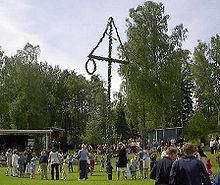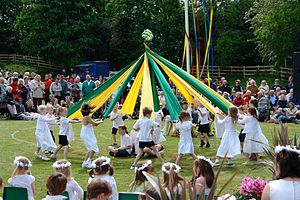- Maypole dance
-
Maypole dancing is a form of folk dance from western Europe, especially England, Basque Country, Sweden, Galicia, Portugal and Germany,
Contents
History
According to the polemic anti-Catholic pamphlet, The Two Babylons, the origin of the maypole dance began in ancient Babylon during sex worship and fertility rites. The church of St Andrew Undershaft in the City of London is named after the maypole that was kept under its eaves and set up each spring until 1517 when student riots put an end to the custom. The maypole itself survived until 1547 when a Puritan mob seized and destroyed it as a "pagan idol".
Forms
There are two distinctive traditions of maypole dancing[citation needed], the circle dance and the ribbon dance.
Circle Dance
Dancers perform circle dances around a tall pole which is decorated with garlands, painted stripes, flowers, flags and other emblems[citation needed]. The circular dance is regarded as the most common and ancient form[citation needed] and is thought by some to have Germanic pagan fertility symbolism, although there is a lack of evidence to support this. The circular dance is traditionally performed in the spring around the festival of May Day, but in Sweden it is during the midsummer festivities.
Ribbon Dance
Dancers gather in a circle, each holding a coloured ribbon attached to a much smaller pole. As the dance commences the ribbons are intertwined and plaited either on to the pole itself or into a web around the pole. The dancers may then retrace their steps exactly in order to unravel the ribbons. This style of maypole dancing originates in the 18th century, and is derived from traditional and 'art' dance forms popular in Italy and France. These were exported to the London stage and reached a large audience, becoming part of the popular performance repertoire. Adopted at a large teacher training institution, the ribbon maypole dance then spread across much of England, and is now regarded as the most 'traditional' of May Day's traditional characteristics.
Examples
Both dance forms can be seen on the same day at the triennial maypole festival held in the village of Barwick-in-Elmet, West Yorkshire. Children of the village school perform a ribbon dance around a small maypole, and later a group of morris dancers perform a circle dance around the main maypole.[1][2]
See also
External links
- Dance History Archives A history of Maypole dancing
- Maypole Dancing FAQ Frequently Asked Questions
- Beltane Activities Maypole Dance Photo Gallery
- A Decade of Maypole Dancing Maypole Dance photos
- whatisguide.net What is Maypole Dancing?
- Barwick-in-Elmet Maypole Trust Children maypole dancing at the triennial maypole festival held in the village of Barwick-in-Elmet, West Yorkshire.
References
- ^ Barwick Maypole Trust. "Maypole Dancing". http://www.barwickmaypole.co.uk. Retrieved 27 February 2011.
- ^ Smith, Harold. "Yorkshire Maypoles". Barwick-in-Elmet Historical Society. http://www.barwickinelmethistoricalsociety.com/barwr10.html. Retrieved 27 February 2011.
Categories:- English folk dance
- Germanic paganism
Wikimedia Foundation. 2010.


